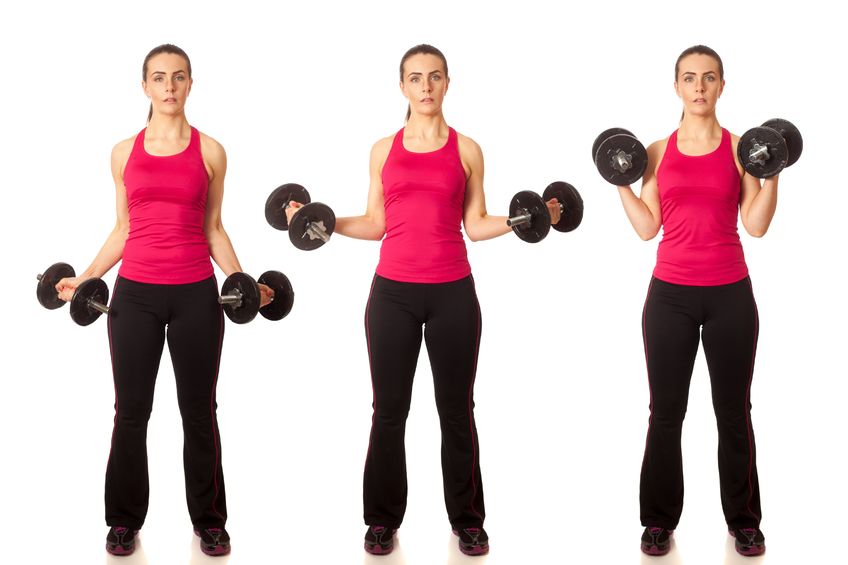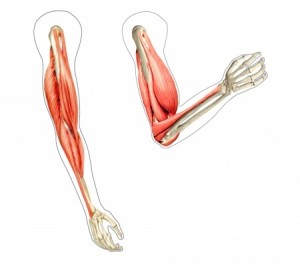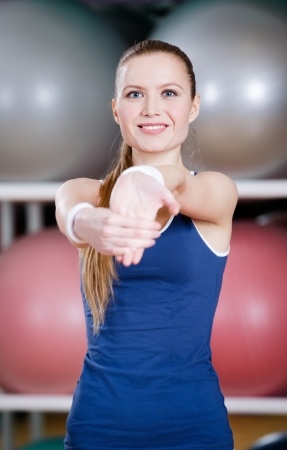Reducing Elbow, Wrist and Hand Injuries through Exercises

Tid Bits of Info
- Exercise daily and ask your Physical Therapist for a proper conditioning program.
- Don’t stop performing your exercises when the pain stops.
- Wearing a wrist splint or Tennis Elbow strap (brace) might reduce your elbow pain.
- Ask your Physical Therapist if wearing a brace is a good thing to do.
- Use the RICE principle if you get injured or develop pain in your hand, wrist or elbow.
- Most people do not get Tennis elbow from playing tennis!
Regular elbow, wrist and hand exercises can help eliminate or reduce severity of injuries. Repetitive actions like using a computer keyboard, raking leaves, and playing tennis may lead to injuries that can cause ongoing pain. This pain can impact simple daily actions like holding a coffee mug or getting dressed. Your physical therapist can help you develop a proper strengthening and stretching conditioning routine to reduce these types of injuries.
Structure of Elbow, Wrist and Hand
The design of the human elbow, wrist and hand enable us to grasp and handle objects of varying sizes, shapes and forms. This simple action requires the ability to generate proper force through the musculature and shape of the joints. The elbow joint links the hand/wrist complex with the shoulder and has musculature that is directly or indirectly associated with the proximal shoulder joint or distal wrist/hand joints.
So the simple of action of using our hands to pick up, hold and manipulate objects involves our whole limb from fingertips through shoulder. Efficient use of the elbow and wrist/hand complex requires proper conditioning from the fingertips through the mid-line of the body (spine).

The proximal stability of the scapulae enables the humerus to move efficiently which in turn becomes a good “anchor” for the distal elbow musculature. The distal elbow musculature is responsible for many (most) of the motions and movements of the wrist and hand that produce the greatest amount of force. Consequently,
Physical Therapists treat many injuries of the elbow that are a result of excess motion or repetitive motions of the wrist and hand. Conditioning the entire limb is a must to help to eliminate injuries or reduce the frequency and severity of the injury should one occur.
The following are several exercises that will hopefully provide a good “base” of upper extremity strength and flexibility. Any person regardless of age or gender can perform these exercises. These are not high-level exercises, but help address injuries due to many normal, routine daily activities. All of us are subject to injury of the elbow, wrist or hand if we are not properly conditioned to enable the joints and their support structures to be able to handle the stress and strains applied to them during activities of daily living.
Strengthening Exercises for Elbow, Wrist and Hand
PULL APARTS: Stand and hold a piece of Theratubing (Rubber tubing can be purchased at most sporting goods stores or ask your Physical Therapist for a piece) of appropriate tensile strength in your hands. Your arms should be at or near shoulder level and your elbows should be fully extended (straight). Your palms should be facing each other so that your thumbs are pointed towards the ceiling. Slowly move your arms apart and stretch/”pull apart” the Theraband. Your goal is to get your hands spread apart with your elbows straight and in line with your shoulders. Your arms should remain parallel to the floor at all times. The final phase of this exercise is to take your shoulder blades and squeeze them together. As the Theraband “recoils” your arms should move slowly back to the starting position. Tip: In the gym, Horizontal Rows on a machine can replace this exercise.
PUSH UPS (STANDARD): The Push Up position can be modified so everyone can perform this exercise. It is great to use to build strength in the chest and arms. The “proper” position is to be prone (face down) on the floor and rise up on your hands and toes. Nothing else should be touching the floor. Your elbows are straight and your hands are shoulder width apart. The push up exercise begins by lowering your body to the floor (don’t touch) and then “push” it back upwards to the starting position. You can modify this exercise by placing your knees on the floor throughout the routine. Tip: In the gym, the Chest Press/Bench Press can be substituted for this exercise.
BICEP CURLS: There are many versions of the Bicep Curl exercise and it can be performed while standing or sitting with or without the elbow held stationary against another object. One way to perform this exercise is to stand with your arms to your sides and the back of your hands are in alignment with your thighs. Hold a dumbbell weight in your hands. Begin to bend your elbows and move the weight upward. At the same time, begin to turn your hands so the palm faces forward and at the top of the “lift” your elbows are fully flexed (bent) and the palm of your hand is facing your chest. Slowly lower the weight to the starting position. The “twisting” of the wrist while you raise or lower the weight enables the entire Biceps muscle to be exercised to its maximum.
Tip: There are numerous Bicep Curl machines in most gyms.
TRICEPS EXTENSION: Like the biceps curl, this exercise can be performed in many ways. One easy way to perform this exercise is to place one knee and the same side hand on a bench or chair. While holding a weight in the hand that is free, press and hold your upper arm (Bicep and Tricep) tightly against your ribs. Your elbow should be touching your side. Slowly extend (straighten) this elbow and move the weight upward and behind you. Pause at the top (full elbow extension) and then return slowly to the beginning position. The upper arm should never move away from your side. Tip: In the gym, a tricep extension exercise can be performed while using a “rope” attachment to the overhead pulley.
WRIST FLEXION: This exercise requires that you support your forearm on a stable object and allow your hand and wrist to be unsupported. While holding a weight in your hand that has the supported forearm, the palm of the hand should be facing the upward. Slowly allow the dumbbell weight to roll down the fingers making sure not to drop it on the floor. Once the fingers are nearly extended, begin the exercise by curling the weight back into the palm of the hand with the fingers. Once the weight is in the palm, begin to flex or curl your wrist so the weight and fingers move towards the forearm. Pause at the top and then return to the starting position to repeat this exercise.
WRIST EXTENSION: Begin by supporting your forearm on a stable object and allowing the hand and wrist to be free and unsupported. Hold a dumbbell weight in your hand with the palm of the hand facing downward. Slowly raise the weight by moving the back of your hand towards the forearm. Pause at the top and then slowly lower the weight to the starting position and repeat.
STRESS BALL SQUEEZE: Find a stress ball, therapeutic puddy, sponge, ball of socks or a rolled towel and begin to squeeze it with all of the fingers. Be sure to incorporate all of the fingers and thumb and all of the joints. The problem with some of the “hand grip” exercisers is that they force the “long” flexor tendons to work and do not promote the entire closure into fully closed fist. This lack of fist closure, does not allow for complete strengthening of intrinsic muscles of the hand or strengthening throughout the entire range of motion of all of the joints of the fingers.
RUBBERBAND FINGER EXTENSION: Place a rubberband (or several) on the ends of your fingers near the finger nails. Slowly spread your fingers apart and feel the resistance of the rubberband. Pause when your fingers are spread out fully and then slowly allow the fingers to return the beginning position. The resistance of the rubberband should be felt throughout the exercise.
WRIST SUPINATION / PRONATION: Sitting with one forearm supported on a stable object, hold a dumbbell weight, screwdriver, hammer or some other weighted object so the object straight up and down. It is perpendicular to the floor. Slowly turn the wrist so the palm of the hand and weight face upwards. Pause when the wrist has traveled through the entire range of motion. Return to the starting position and then proceed to turn the wrist in the opposite direction which places the weight the palm of the hand facing the floor. Pause and then return to the beginning position.
Stretching Exercises for Elbow, Wrist and Hand
 WRIST FLEXION: Standing or sitting, fully extend your elbows with the palms of your hands facing the floor. Place one hand on the back of the opposite hand. The hand to be stretched is the bottom hand. Slowly push the bottom hand towards the floor and allow the wrist to bend (flex) as far as possible without causing sharp pain. Hold the stretch and then repeat.
WRIST FLEXION: Standing or sitting, fully extend your elbows with the palms of your hands facing the floor. Place one hand on the back of the opposite hand. The hand to be stretched is the bottom hand. Slowly push the bottom hand towards the floor and allow the wrist to bend (flex) as far as possible without causing sharp pain. Hold the stretch and then repeat.
Part two of this stretch involves closing the bottom hand into a loosely closed fist. Repeat the stretching routine as described above.
WRIST EXTENSION: Standing or sitting, fully extend both arms. The palm of the hand to be stretched should be facing the ceiling. Put your fingers of the other hand on the fingers of the bottom hand and slowly push the bottom hand towards the floor. The wrist of the bottom hand will be pushed into an extended position and the stretch will be felt in the forearm.
Elbow, wrist and hand functions are related closely. Many times an injury to one will negatively affect one of the other parts. A proper conditioning program can greatly increase the strength and muscular endurance of the arm musculature and help to reduce the frequency or severity of injury to these body parts.
























